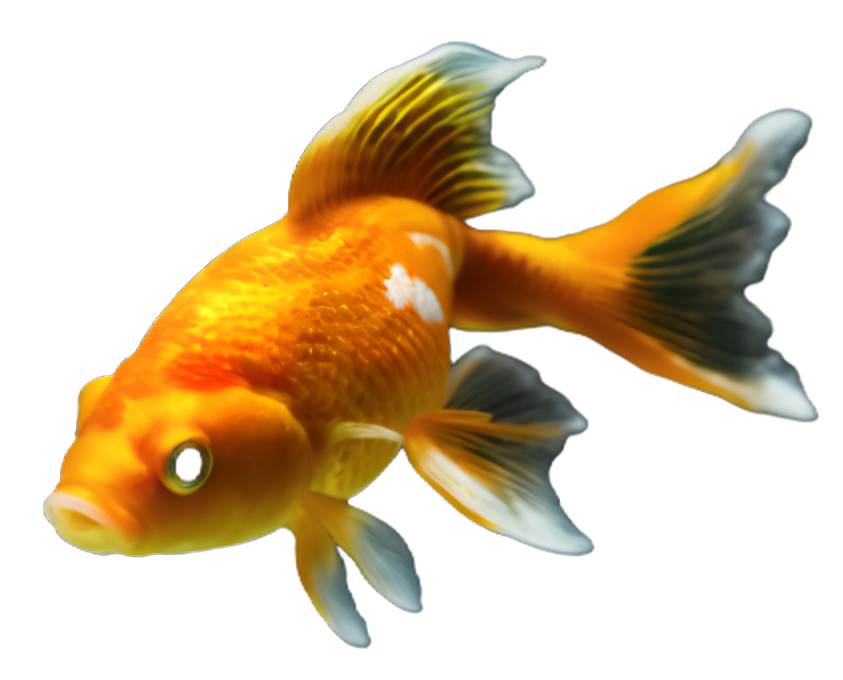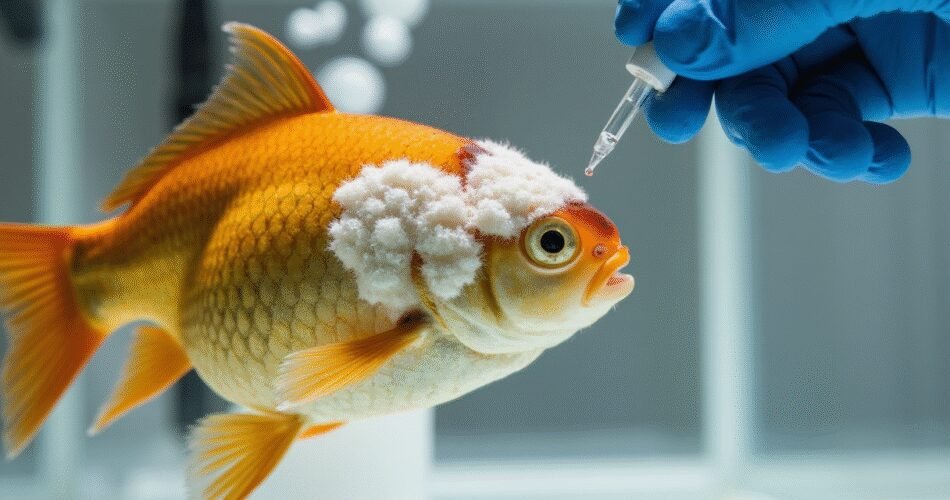Spotting Goldfish Fungal Infections Early 🐠
I’ve dealt with my fair share of goldfish fungal infections, and let me tell you, they’re no joke. If I ever notice fluffy white or gray patches on my fish’s fins, body, or eyes, I know I’m likely looking at one of the most common fungal infections in goldfish. These infections usually pop up when my fish is stressed or living in poor water conditions—think dirty tanks, sudden temperature changes, or injuries that aren’t healing right.
Ignoring the symptoms of fungal infections in goldfish is a big mistake. Left untreated, they can quickly spread, damage tissue, and even become fatal. That’s why I always act fast at the first sign of trouble. Protecting my goldfish health starts with recognizing issues early and using the right treatments. Trust me, my fish thank me for it.
Identifying Symptoms of Fungal Infections in Goldfish 🔍
I always keep a close eye on my goldfish for any symptoms of fungal infections. Spotting these goldfish fungal infection signs early can make a huge difference in treatment success. The most common visual clue is white or grayish cotton-like growths on the skin, fins, or gills. I might also notice patches of discoloration, frayed or ragged fins, or small raised tufts that look fuzzy.
Behaviorally, infected fish often act lethargic, lose their appetite, or rub against objects in the tank. Gasping at the surface or clamping their fins close to their body are also red flags. If I see any of these early signs of fungus on goldfish, it’s time to act fast. I recommend using a reliable antifungal treatment to give my fish the best chance of recovery.
Common Types of Fungi Affecting Goldfish 🧫
I’ve dealt with my fair share of goldfish fungal species over the years, and the most common culprit is Saprolegnia in goldfish. This fuzzy, cotton-like growth often appears on wounds or stressed fish, thriving in poor water conditions. It’s one of the main types of fungi in goldfish I encounter, but it’s not the only one.
Other fungal pathogens in aquarium fish include Achlya and Branchiomyces, which can affect gills and skin. I always keep a close eye on water quality and fish behavior to catch these early. For treatment, I rely on reliable antifungal medications specifically designed for goldfish.
How Water Quality Prevents Fungal Infections 💧
I’ve learned the hard way that keeping my goldfish healthy starts with water quality for goldfish. Poor water conditions stress fish, making them vulnerable to fungal infections. It’s not just about clear water—it’s about maintaining the right water parameters to prevent fungus.
I test my aquarium regularly for ammonia, nitrites, and nitrates. High levels of these can weaken my goldfish’s immune system, inviting fungal outbreaks. I also keep an eye on pH and temperature, as stability matters. Clean, well-filtered water reduces the need for medications.
When I prioritize water quality for goldfish, I see fewer health issues. It’s my first line of defense—better than treating problems later.
Best Medications for Goldfish Fungal Infections 💊
When I’m dealing with a goldfish fungal infection, I always start by checking my options for OTC goldfish antifungal treatments. I’ve found that some of the most reliable over-the-counter fungal infection medications include Methylene Blue, Pimafix, and API Fungus Cure. Each works a bit differently, but they’re all effective when used correctly.
Here’s how I use them:
- Methylene Blue: I add it directly to a quarantine tank—never the main aquarium, as it can harm beneficial bacteria. I follow the dosage on the label carefully.
- Pimafix: This one’s natural and safe with other fish. I measure it based on tank size and apply daily for a week.
- API Fungus Cure: I dissolve the powder in tank water before adding it. I usually treat for 4-5 days, and I always remove carbon filters first.
I make sure to isolate the sick fish, maintain clean water, and follow the product instructions exactly. Consistency is key—I never skip doses. These over-the-counter antifungal treatments for goldfish have saved my fish more than once when I acted fast and stuck to the plan.
Prescription Medications and When to Use Them 🏥
I always start by asking myself: when is it time to use prescription antifungal goldfish treatments? If I notice a fungal infection that doesn’t clear up with over-the-counter options, or if it looks severe—like cotton-like growths that spread quickly—I know it’s time for stronger veterinary medicines for fish.
When to use prescription meds for goldfish fungus becomes clear in cases where the infection is deep, recurring, or not responding to basic treatments. That’s when I reach for veterinarian recommended antifungal treatments such as ketoconazole or other prescribed formulas. These are targeted, potent, and much safer under professional guidance.
Don’t hesitate—if I’m seeing persistent symptoms, I consult a vet. Delaying can risk my goldfish’s health. Trust me, using the right prescription approach early can make all the difference.
Natural and Home Remedies for Treating Fungus 🌿
When I notice signs of fungal infection in my goldfish, I turn to natural antifungal remedies and home treatments for goldfish fungus right away. One of my go-to methods is using salt to treat goldfish fungus—it’s gentle and effective. I dissolve aquarium salt in a separate container and give my fish short baths daily. It helps slow down the infection without stressing them out.
I also rely on natural medicine for aquarium fungus, like adding a few drops of tea tree oil to the water or using garlic-infused food. Both have antifungal properties and support my fish’s immune system. These home treatments are easy to apply and work well for mild cases, though I always keep a close eye on water quality and fish behavior.
For persistent infections, I consider stronger options like the Best medications for goldfish fungal infections, but starting with natural approaches gives my fish a fighting chance with minimal chemical intervention.
Dosage and Safety Tips for Administering Medications ⚠️
I’ve treated many goldfish with fungal infections, and getting the medication dosage right is the most important step. When I use antifungal meds for goldfish, I always follow the product instructions exactly—never guess. Underdosing won’t treat the infection, and overdosing can harm my fish or crash my tank’s cycle.
For safe antifungal treatment for goldfish, I stick to the recommended treatment duration, usually 5–7 days. I never stop early, even if the fish looks better. I also remove chemical filtration like carbon, since it can absorb the medication and reduce effectiveness.
To minimize stress, I keep the water clean and well-aerated. I always quarantine sick fish if possible to protect others and make dosing easier. When using any medication, safety comes first—I protect my goldfish by measuring carefully and observing closely.
Monitoring Recovery and When to Seek Professional Help 📈
When treating my goldfish for a fungal infection, I keep a close eye on signs of improvement. I look for clearer skin, better appetite, and more active swimming—these are the positive signs of improvement in a fungal infection goldfish. If the cotton-like patches shrink and the fins start to heal, I know the treatment is working.
But if things don’t get better within a few days, or if my goldfish seems worse—lethargic, not eating, or developing secondary issues—those are clear indicators to consult an aquatic veterinarian. I don’t wait if there’s no progress or if new symptoms appear. A vet can prescribe stronger treatments or rule out underlying problems. It’s critical to act fast; delaying can risk my goldfish’s health.
Best Practices for Prevention and Treatment ✅
I’ve learned that the best way to prevent fungal infections in goldfish starts with clean water and a stress-free environment. I make sure I’m doing regular water changes and keeping an eye on water parameters. If I notice any fuzzy white patches on my fish, that’s a clear sign of fungus—I don’t wait to act.
For effective treatment of goldfish fungus, I always begin with isolating the affected fish and using antifungal medications. Over the years, I’ve found that products like Best medications for goldfish fungal infections work well when used as directed. But I remember, medication is just part of the solution—supportive care like clean water and proper nutrition is crucial.
I stick to these best practices for goldfish fungal infection care: stay vigilant, act quickly, and always follow treatment guidelines. With the right approach, I can keep my goldfish healthy and thriving.

